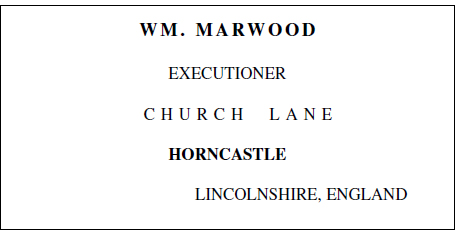
Marwood’s professional calling-card.
The first criminal to experience the new ‘long drop’ was William Berry in 1872. He was the son of a Boston man, and had made a new life for himself in Staffordshire, but he came back to Boston, and there he developed a crazy obsessional jealousy about his wife and this inevitably led to his murdering her.
When the Bradford man, James Berry, took over the post in 1884, he paid a visit to Lincoln and disposed of Arthur Spencer in 1891. Spencer was only twenty-two and had fallen in love with a widow older than himself; she rebuffed him and he turned violent. He shot her at point blank, but they bungled his attempt at suicide. Amazingly, the muzzle placed in his mouth and discharged, sent the bullet out of the back of his neck and he survived.
Berry’s other visit to Lincoln was to execute a Grimsby sailor, Richard Insole, in 1887. He had killed his wife in a fit of jealousy. By the end of the nineteenth century, the death cell at Greetwell Road had been visited by three hangmen, and some of the men figuring in the Scunthorpe stories were seen out of this world in the death cell there. The last man from the Scunthorpe area to hang in Lincoln was Kenneth Roberts, whose story has been told already. But Lincoln prison has another interesting story with regard to the last hangman employed there: this was Syd Dearnley, who came to the prison for the job interview in 1948. The Governor, Brigadier Paton-Walsh, wrote that he should come ‘to be medically examined and interviewed with a view to ascertaining your fitness for the post of assistant executioner.’ He did so, and at the interview, when he spoke about hobbies, he confessed to enjoy pheasant shooting in Clumber Park.
But it is hard to think lightly about anything to do with hanging a man. At Lincoln prison, the arrangements and ritual were no different to most other prisons with a calendar of executions on their records. Marwood and his successors, the Pierrepoint family and later Steve Wade, became familiar with the sequence of events before the lever was pulled and the condemned person fell to the lower level, their asphyxiation very rapid.
Finally, where there has been so much death and misery, one might expect stories of paranormal happenings. It may come as no surprise to learn that in Lincoln prison, there have been numerous sightings of a figure in the administration block: he is reputed to be the restless spirit of Frederick Nodder, a killer hanged there in 1937 for the murder of little Mona Tinsley in Newark. The offices are built over what used to be the prison graveyard.
In the story of the killer Travis in Kirton, the legend now around the area is that around a five-barred gate on Leonard Field, no grass would grow on the spot where Kirton farmer John Copeman was savagely killed in 1847. One tradition says that at the spot where this happened, a roadman kept the area grass-free, as people would come to stare and take a less than healthy interest in the murder site. Copeman’s body was first found lying in the Grayingham road, close to the Kirton side of the gate in Leonard’s Field.
How men from around Axholme, Scunthorpe and Barton must have dreaded the short trip south down the Roman road, to the city where so many had breathed their last at the hands of the law.